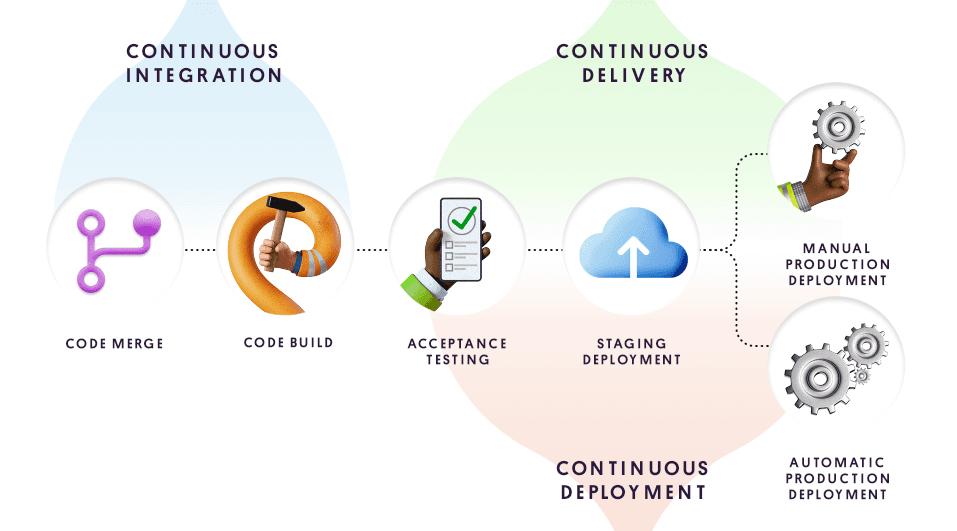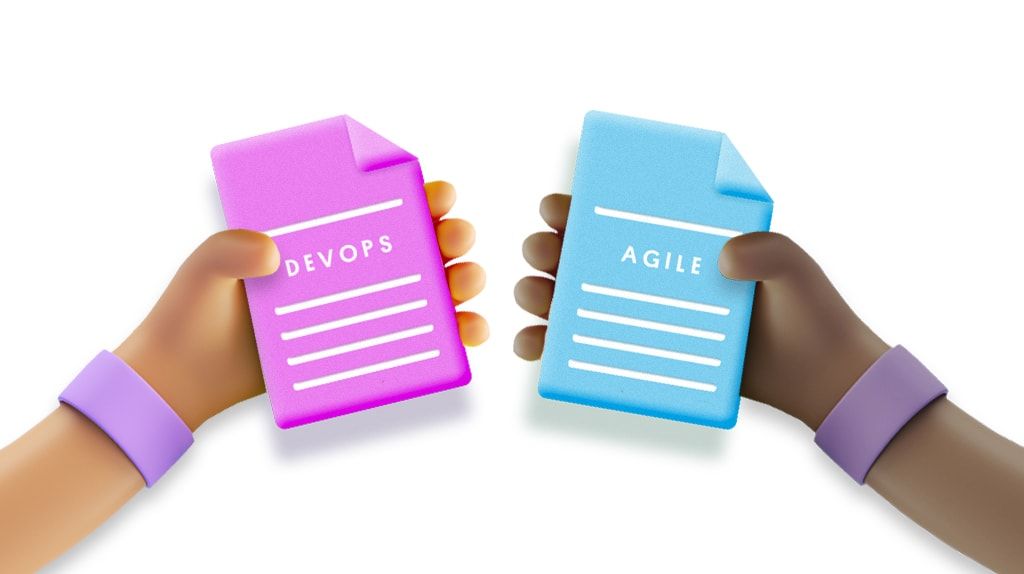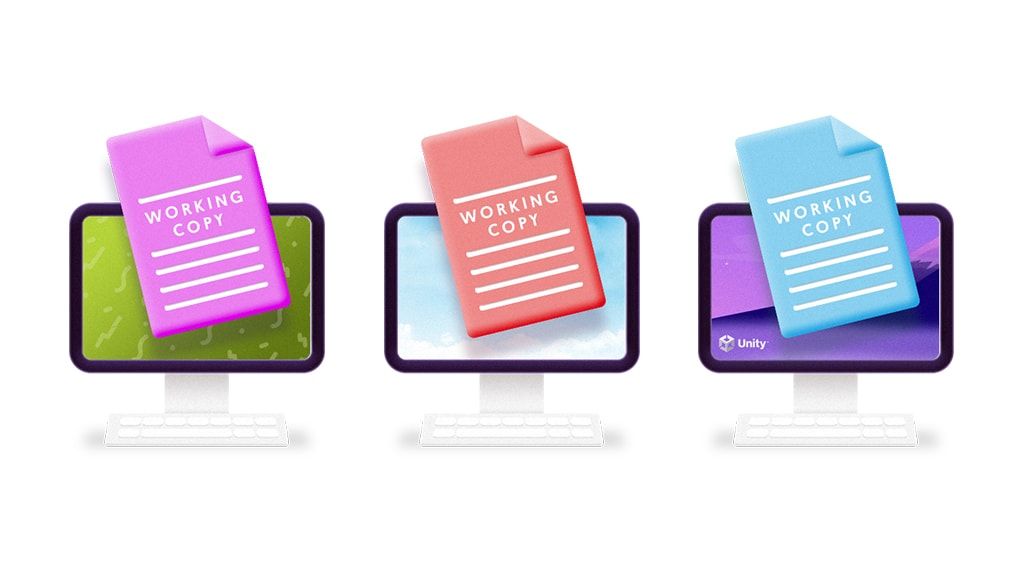
CI/CD란?

CI/CD 설명
CI/CD는 여러 DevOps 단계를 아우르는 포괄적인 용어입니다. CI(지속적 통합)은 코드 변경 사항을 하루에 여러 차례 저장소에 통합하는 방식입니다. CD에는 지속적 제공을 통해 코드 통합을 자동화하거나 지속적 배포를 통해 최종 빌드를 최종 사용자에게 자동으로 릴리스한다는 두 가지 의미가 담겨 있습니다. CI/CD에서 빈번하게 수행되는 테스트로 코드 오류와 결함이 줄어들므로 CI/CD는 모든 DevOps 워크플로에 중요한 역할을 합니다.
지속적인 통합이란 무엇입니까? (CI)
CI는 DevOps 베스트 프랙티스이자 개발자들이 하루에 여러 차례 수시로 코드를 공통 코드 저장소에 체크인하는 DevOps 라이프사이클 단계입니다. 이런 일이 일어날 때마다 자동화된 빌드 툴이 체크인이나 브랜치를 검증하여 오류가 없는지 확인하므로 제작 단계로 바로 진행할 수 있습니다. 여기서 얻을 수 있는 주 이점은 일반적으로 문제가 더 심화되기 전에 조기에 발견된다는 점입니다.
CI를 구현하면 소요 시간이 긴 중대한 업데이트가 아닌 사소한 변경 사항을 단기간에 통합할 수 있습니다. 테스트, 병합, 공통 저장소에 변경 사항 체크인 작업 워크플로를 자동화하면 팀이 더욱 신속히 깔끔한 코드를 제공할 수 있습니다. 깔끔한 코드를 통해 빠르게 검증하고, 보다 깔끔한 릴리스를 제공하고, 확장이 용이한 개발 파이프라인의 효율성을 향상할 수 있습니다.
지속적인 통합은 어떻게 작동합니까?
CI는 DevOps 베스트 프랙티스이자 개발자들이 하루에 여러 차례 수시로 코드를 공통 코드 저장소에 체크인하는 DevOps 라이프사이클 단계입니다. 이런 일이 일어날 때마다 자동화된 빌드 툴이 체크인이나 브랜치를 검증하여 오류가 없는지 확인하므로 제작 단계로 바로 진행할 수 있습니다. 여기서 얻을 수 있는 주 이점은 일반적으로 문제가 더 심화되기 전에 조기에 발견된다는 점입니다.
CI를 구현하면 소요 시간이 긴 중대한 업데이트가 아닌 사소한 변경 사항을 단기간에 통합할 수 있습니다. 테스트, 병합, 공통 저장소에 변경 사항 체크인 작업 워크플로를 자동화하면 팀이 더욱 신속히 깔끔한 코드를 제공할 수 있습니다. 깔끔한 코드를 통해 빠르게 검증하고, 보다 깔끔한 릴리스를 제공하고, 확장이 용이한 개발 파이프라인의 효율성을 향상할 수 있습니다.
CI의 규칙과 원칙
CI는 DevOps 베스트 프랙티스이자 개발자들이 하루에 여러 차례 수시로 코드를 공통 코드 저장소에 체크인하는 DevOps 라이프사이클 단계입니다. 이런 일이 일어날 때마다 자동화된 빌드 툴이 체크인이나 브랜치를 검증하여 오류가 없는지 확인하므로 제작 단계로 바로 진행할 수 있습니다. 여기서 얻을 수 있는 주 이점은 일반적으로 문제가 더 심화되기 전에 조기에 발견된다는 점입니다.
CI를 구현하면 소요 시간이 긴 중대한 업데이트가 아닌 사소한 변경 사항을 단기간에 통합할 수 있습니다. 테스트, 병합, 공통 저장소에 변경 사항 체크인 작업 워크플로를 자동화하면 팀이 더욱 신속히 깔끔한 코드를 제공할 수 있습니다. 깔끔한 코드를 통해 빠르게 검증하고, 보다 깔끔한 릴리스를 제공하고, 확장이 용이한 개발 파이프라인의 효율성을 향상할 수 있습니다.

지속적인 배포 vs 지속적인 배포
지속적 제공은 CI 다음에 이루어지며, 이를 최종 제품이 고객에게 출시되거나 배포되기 전에 개발 파이프라인에서 확인하는 체크포인트 단계라고 생각하면 됩니다. 코드 변경 사항이 검증된 후에는 저장소로 자동 전달됩니다.
지속적 제공의 목표는 최종 제품이 출시될 준비가 되지 않은 경우 기본 빌드에 업데이트하지 않아도 최종 제품의 '정식으로 제작에 사용 가능' 상태가 유지될 만큼 사소한 체인지 세트는 유지하는 것입니다. 최종 제품에 사소한 오류가 있을 수 있으나 사용자 경험을 저해할 만큼 중대한 오류는 아닙니다.
지속적 제공을 구현하면 처음부터 안정적인 코드만 제공되므로 개발자는 자체적으로 테스트하는 데 소요되는 시간을 단축할 수 있습니다. 이를 통해 버그 감지 프로세스가 간단해져 해결에 걸리는 시간을 줄일 수 있습니다.
CI/CD와 DevOps 어떻게 연관 ⁇ 니까?
DevOps는 소프트웨어 개발 효율성 향상을 목표하는 문화이자 프로세스입니다.
CI/CD 파이프라인은 일련의 특정 단계로, DevOps 라이프사이클을 실현하는 툴 그리고 자동화와 연결되어 있습니다. CI/CD는 DevOps 문화의 필수 요소이며, DevOps는 협업에서 팀 구조, 관찰, 버전 관리 등에 이르기까지 소프트웨어 개발 라이프사이클 전반을 포괄적으로 아우릅니다.
DevOps는 조직 전반에서 매우 다양하게 구현될 수 있지만, CI/CD 없이는 실현될 수 없다는 점이 핵심입니다. CI/CD 파이프라인은 본질적으로 DevOps 문화와 더불어 빈번한 소규모 릴리스 프로세스와 연결되어 있습니다.
CI/CD의 이점
신속한 반복 작업
DevOps 라이프사이클의 일환으로 CI/CD 방식을 채택하면 코드 베이스 관련 변경 사항을 검증하고 배포하는 수동 작업을 자동화함으로써 개발 속도를 높일 수 있습니다.
클리너 코드
하루 종일 수많은 사소한 변경 사항을 확인하면 소스 코드로 유입되어 빌드를 손상시키는 오류가 발생할 위험을 크게 줄일 수 있습니다.
더 빠른 버그 수정
CI/CD를 통해 소규모 체인지 세트를 더 자주 병합하면 코드 오류가 더 큰 문제로 발전하기 전에 손쉽게 이를 식별하고 해결할 수 있습니다.
짧은 피드백 루프
CI/CD를 통해 반복적으로 발생하는 사소한 변경 사항을 손쉽게 통합, 테스트, 배포할 수 있어 피드백 루프를 단축할 수 있습니다.
더 나은 협업
CI/CD는 코드를 커밋하고 빌드를 출시하기 위한 프로세스와 일정을 정립함으로써 작업에 명확성을 더합니다. 보다 명확해진 목표를 통해 팀은 향상된 민첩성에 대응할 수 있습니다.
행복한 고객
CI/CD를 통해 빌드가 출시 준비 완료 상태이므로 고객이 서비스 중단을 경험할 가능성이 줄어들 뿐 아니라 고객 피드백이 훨씬 빠르게 통합될 수 있습니다.
추가 DevOps 리소스

애자일과 DevOps 비교
애자일과 DevOps는 주기적인 릴리스 일정을 통해 고객 가치를 제공한다는 점에서 동일한 목표를 가지고 있지만, 접근 방식에서 다소 차이가 있습니다. 애자일과 DevOps를 함께 사용하는 방법을 알아보세요.

DevOps의 이점
DevOps 방식을 구현하면 개발 파이프라인을 간소화하고 팀과 사용자의 만족도를 향상할 수 있습니다. DevOps를 사용하면 어떤 도움이 되는지 알아보세요.

소스 코드 관리 이해
SCM(소스 코드 관리)은 팀이 신속하게 작업하고 효율적으로 협업하는 데 도움이 됩니다. 버전 관리 툴, 사용 시기 및 작동 방식에 대해 알아야 할 모든 내용을 알아보세요.

유니티의 CI/CD 솔루션을 사용하여 반복 작업을 신속히 수행하고 효과적인 소스 코드 관리 및 자동화 기능을 프로젝트에 활용하세요. 분산된 작업의 경우 Unity Cloud Build를 선택하거나 Unity Build Server를 사용해 온프레미스 빌드 용량을 확장하세요.